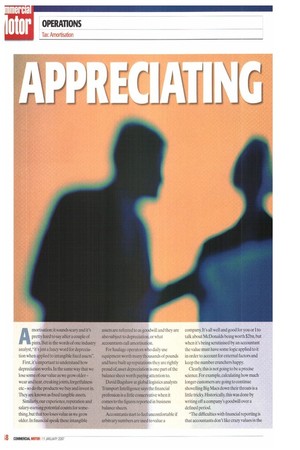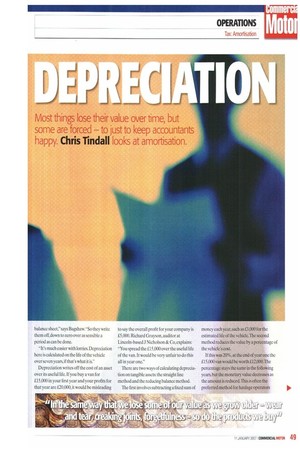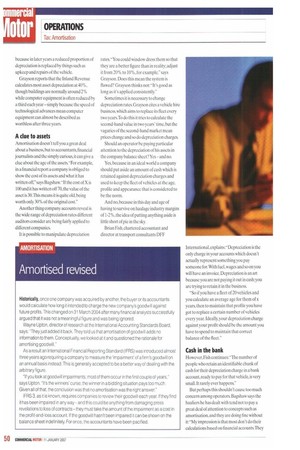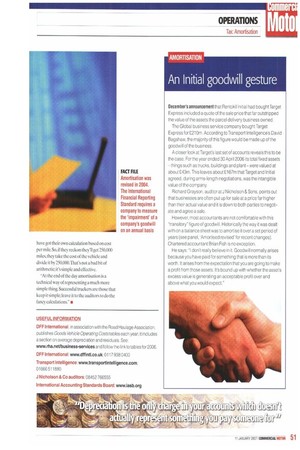APPRECJATING
Page 48

Page 49

Page 50

Page 51

If you've noticed an error in this article please click here to report it so we can fix it.
Most things lose their value over time, but some are forced — to just to keep accountants
happy. Chris Tindall looks at amortisation.
Amorlisation t'souns s scary andit's pretty hard to say after a couple of pints. But in the words of one industry analyst, "it 's just a fancy word for depreciation when applied to intangible fixed assets".
First, ifs important to understand how depreciation works. In the same way that we lose some of our value as we grow older — wear and tear, creaking joints. forgetfulness etc—so do the products we buy and invest in. They are known as fixed tangible assets.
Similarly, our experience, reputation and salary-earning potential counts for something, but that too loses value as we grow older, In financial speak these intangible assets are referred to as goodwill and they are also subject to depreciation, or what accountants call amortisation.
For haulage operators who daily use equipment worth many thousands of pounds and have built up reputations they are rightly proud oI asset depreciation is one part of the balance sheet worth paying attention to, David Bagshaw at global logistics analysts Transport Intelligence says the financial profession is a little conservative when it comes to the figures reported in business balance sheets.
Accountants start to feel uncomfortable if arbitrary numbers are used lo value a company. It's all well and good for you or Ito talk about McDonalds being worth $2bn, but when it's being scrutinised by art accountant the value must have some logic applied to it in order to account for external factors and keep the number crunchers happy.
Clearly, this is not going to be a precise science. For example, calculating how much longer customers are going to continue shovelling Big Macs down their throats is a little tricky. Historically, this was done by writing off a company's goodwill over a defined period.
"The difficulties with financial reporting is that accountants don't like crazy values in the balance sheet," says Bagshaw."So they write them off, down to zero over as sensible a period as can be done.
"It's much easier with lorries. Depreciation here is calculated on the life of the vehicle over seven years, if that's what it is."
Depreciation writes off the cost of an asset over its useful life. If you buy a van for £15,000 in your first year and your profits for that year are £20,000, it would be misleading to say the overall profit for your company is £5,000. Richard Grayson, auditor at Lincoln-based J Nicholson & Co, explains: "You spread the £15,000 over the useful life of the van. It would be very unfair to do this all in year one."
There are two ways of calculating depreciation on tangible assets: the straight line method and the reducing balance method.
The first involves subtracting a fixed sum of money each year, such as £3,000 for the estimated life of the vehicle.The second method reduces the value by a percentage of the vehicle's cost.
If this was 20%, at the end of year one the £15,000 van would be worth £12,000.The percentage stays the same in the following years, hut the monetary value decreases as the amount is reduced.This is often the preferred Method for haulage operators because in later years a reduced proportion of depreciation is replaced by things such as upkeep and repairs of the vehicle.
Grayson reports that the Inland Revenue calculates most asset depreciation at 40%, though buildings are normally around 2% while computer equipment is often reduced by a third each year —simply because the speed of technological advances mean computer equipment can almost be described as worthless after three years.
A due to assets
Amortisation doesn't tell you a great deal about a busi ness, but to accountants, financial journalists and the simply curious, it can give a clue about the age of the assets."For example, in a financial report a company is obliged to show the cost of its assets and what it has written off," says Bagshaw."If the cost of X is 100 and it has written off 70, the value of the asset is 31). This means it is quite old, being worth only 30% of the original cost."
Another thing company accounts reveal is the wide range of depreciation rates different auditors consider are being fairly applied to different companies.
It is possible to manipulate depreciation rates, "You could window dress them so that they are a better figure than in reality; adjust it from 20% to 10`)/0, for example," says Grayson. Does this mean the system is flawed? Grayson thinks not: "It's good as long as it's applied consistently."
Sometimes it is necessary to change depreciation rates. Grayson cites a vehicle hire business, which aims to replace its fleet every two years. To do this it tries to calculate the second-hand value in two years' time, but the vagaries of the second-hand market mean prices change and so do depreciation charges.
Should an operator be paying particular attention to the depreciation of his assets in the company balance sheet? Yes — and no.
Yes, because in an ideal world a company should put aside an amount of cash which is retained against depreciation charges and used to keep the fleet of vehicles at the age, profile and appearance that is considered to be the norm.
And no, because in this day and age of having to survive on haulage industry margins of 1-2%, the idea of putting anything aside is little short of pie in the sky.
Brian Fish, chartered accountant and director at transport consultants DFF International, explains: "Depreciation is the only charge in your accounts which doesn't actually represent something you pay someone for. With fuel, wages and so on you will have an invoice. Depreciation is an art because you are not paying it out in cash; you are trying to retain it in the business.
"So if you have a fleet of 20 vehicles and you calculate an average age for them of x years, then to maintain that profile you have got to replace a certain number of vehicles every year. Ideally, your depreciation charge against your profit should be the amount you have to spend to maintain that correct balance of the fleet."
Cash in the bank
However, Fish continues:"The number of people who retain an identifiable chunk of cash for their depreciation charge in a bank account, ready to pay for that vehicle, is very small. It rarely ever happens."
But perhaps this shouldn't cause too much concern among operators. Bagshaw says the hauliers he has dealt with tend not to pay a great deal of attention to concepts such as amortisation, and they are doing fine without it:"My impression is that most don't do their calculations based on financial accounts.They have got their own calculation based on cost per mile. So, if they reckon they'll get 250,000 miles, they take the cost of the vehicle and divide it by 250,000.That's not a had bit of arithmetic; it's simple and effective.
-At the end of the day amortisation is a technical way of representing a much more simple thing. Successful truckers are those that keep it simple; leave it to the auditors to do the fancy calculations," •










































































































































































